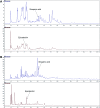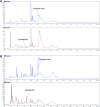Comparative study of young shoots and the mature red headed cabbage as antioxidant food resources with antiproliferative effect on prostate cancer cells
- PMID: 35514921
- PMCID: PMC9058263
- DOI: 10.1039/d0ra07861a
Comparative study of young shoots and the mature red headed cabbage as antioxidant food resources with antiproliferative effect on prostate cancer cells
Abstract
The increasing knowledge on health benefit properties of plant origin food ingredients supports recommendations for the use of edible plants in the prevention of diet related diseases, including cancer. The beneficial effects of young shoots of red cabbage can be attributed to their mixture of phytochemicals possessing antioxidant and potential anticancer activity. The objective of this study was to compare the content of bioactive compounds, including HPLC analysis of polyphenols and antioxidant activity of young shoots of red cabbage and the vegetable at full maturity. The content of vitamin C and polyphenols in juices obtained from young shoots and the mature vegetable were also determined. The other aim of this study was to confirm the hypothesis that juice of young shoots more effectively, compared to juice of the mature vegetable, reduces the proliferation of prostate cancer cell lines DU145 and LNCaP in vitro. A significantly higher content of vitamin C and carotenoids, as well as a higher antioxidant activity were found in edible young shoots in comparison to the mature vegetable. In addition, studies have shown higher amount of vitamin C in the juice of young shoots than in the juice of the mature vegetable and similar content of polyphenolic compounds. The level of total polyphenol content in the studied plant samples did not differ significantly. Flavonoids were the main polyphenols in young shoots and juice obtained from them, while phenolic acids were dominant in the mature vegetable and in juice obtained from it. The juice of young shoots has shown stronger in vitro anti-proliferation effect against prostate cancer cells than juice of the mature vegetable.
This journal is © The Royal Society of Chemistry.
Conflict of interest statement
There are no conflicts to declare.
Figures





Similar articles
-
Young Shoots of White and Red Headed Cabbages Like Novel Sources of Glucosinolates as Well as Antioxidative Substances.Antioxidants (Basel). 2021 Aug 12;10(8):1277. doi: 10.3390/antiox10081277. Antioxidants (Basel). 2021. PMID: 34439525 Free PMC article.
-
Antioxidant Properties and Phenolic Compounds of Vitamin C-Rich Juices.J Food Sci. 2018 Aug;83(8):2237-2246. doi: 10.1111/1750-3841.14284. Epub 2018 Jul 25. J Food Sci. 2018. PMID: 30044505
-
Effect of high-pressure processing applied as pretreatment on carotenoids, flavonoids and vitamin C in juice of the sweet oranges 'Navel' and the red-fleshed 'Cara Cara'.Food Res Int. 2020 Jun;132:109105. doi: 10.1016/j.foodres.2020.109105. Epub 2020 Feb 19. Food Res Int. 2020. PMID: 32331674
-
Pomegranate juice as a functional food: a comprehensive review of its polyphenols, therapeutic merits, and recent patents.Food Funct. 2020 Jul 1;11(7):5768-5781. doi: 10.1039/d0fo01251c. Epub 2020 Jul 1. Food Funct. 2020. PMID: 32608443 Review.
-
Alternatives to conventional thermal treatments in fruit-juice processing. Part 2: Effect on composition, phytochemical content, and physicochemical, rheological, and organoleptic properties of fruit juices.Crit Rev Food Sci Nutr. 2017 Feb 11;57(3):637-652. doi: 10.1080/10408398.2014.914019. Crit Rev Food Sci Nutr. 2017. PMID: 25894933 Review.
Cited by
-
Morphological and Photosynthetic Parameters of Green and Red Kale Microgreens Cultivated under Different Light Spectra.Plants (Basel). 2023 Nov 8;12(22):3800. doi: 10.3390/plants12223800. Plants (Basel). 2023. PMID: 38005697 Free PMC article.
-
Unraveling the In Vitro Anti-Advanced Glycation End-Product (Anti-AGE) Potential of Fermented Red Cabbage and Beetroot: Insights into Composition and Activities.Foods. 2024 Jun 7;13(12):1791. doi: 10.3390/foods13121791. Foods. 2024. PMID: 38928733 Free PMC article.
-
Genus Brassica By-Products Revalorization with Green Technologies to Fortify Innovative Foods: A Scoping Review.Foods. 2023 Jan 27;12(3):561. doi: 10.3390/foods12030561. Foods. 2023. PMID: 36766089 Free PMC article.
-
Dietary Polyphenols: Extraction, Identification, Bioavailability, and Role for Prevention and Treatment of Colorectal and Prostate Cancers.Molecules. 2022 Apr 29;27(9):2831. doi: 10.3390/molecules27092831. Molecules. 2022. PMID: 35566182 Free PMC article. Review.
-
Sustainable Recovery of Anthocyanins and Other Polyphenols from Red Cabbage Byproducts.Foods. 2023 Nov 17;12(22):4157. doi: 10.3390/foods12224157. Foods. 2023. PMID: 38002214 Free PMC article.
References
-
- Wang S. Meckling K. A. Marcone M. F. Kakuda Y. Tsao R. Can phytochemical antioxidant rich foods act as anti-cancer agents? Food Res. Int. 2011;44:2545–2554. doi: 10.1016/j.foodres.2011.05.021. - DOI
LinkOut - more resources
Full Text Sources

